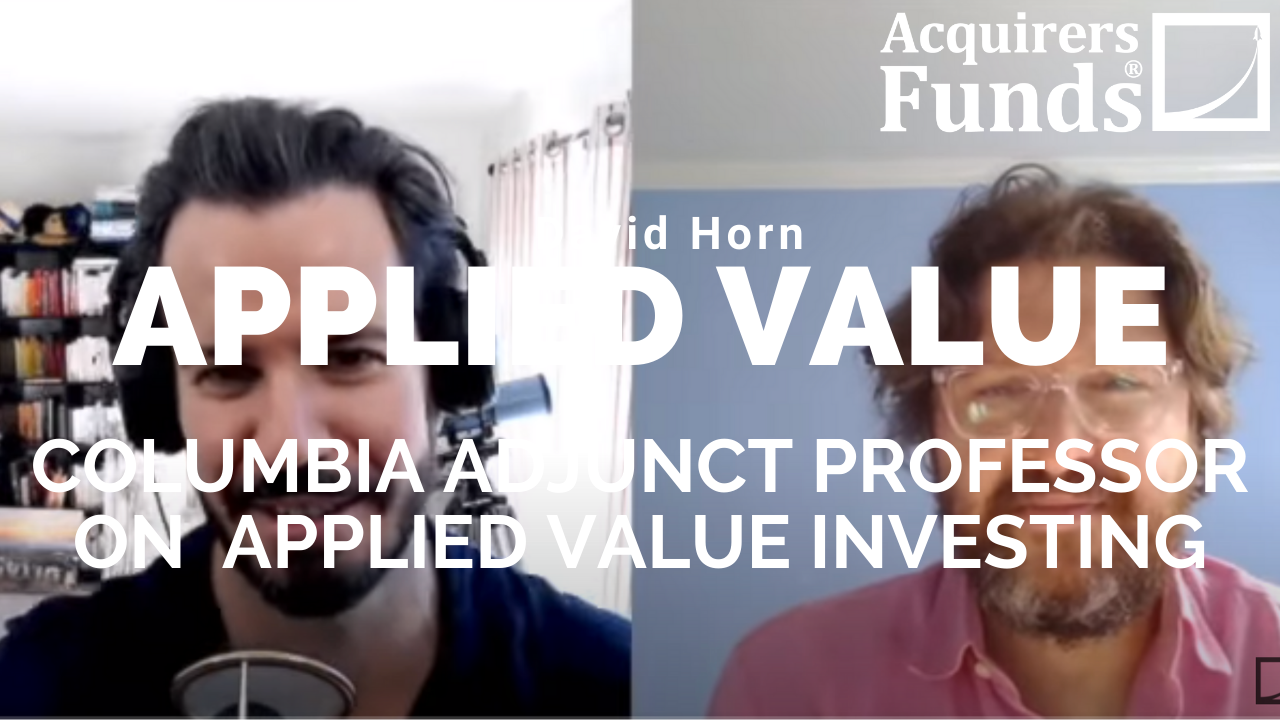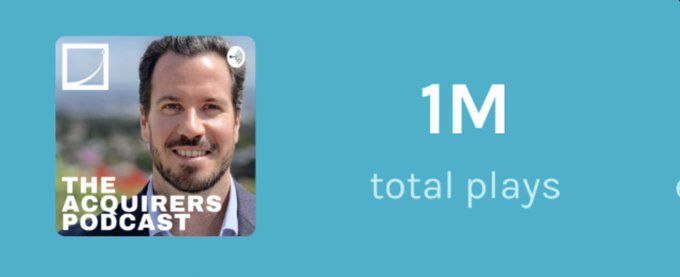During his recent interview with Tobias, David Horn, Adjunct Professor of Applied Value Investing at Columbia Business School, discussed Endogenous Versus Exogenous Rates Of Return. Here’s an excerpt from the interview:
David: Let’s get in a little bit. And this came into– we’ve tweaked a little bit about this, and this was in a chain by, whatever, SuperMugatu. Talking about is value dead, and I know you recently had a pod with with Cliff Asness, and he was talking about the fact that for seven years–
Tobias: It was justified.
David: It was justified. This brings into my question, what is value? We’re defining it by price to book screen. And I guess, to say something, if the stocks weren’t getting cheaper, or if the earnings were declining in line with the multiple staying low, and then the companies were underperforming, then I don’t even know if you call that a trap. I think you call that wrong. So, I think what’s important is– Okay, so let’s dig into, so what’s happening underneath the surface? Unfortunately, I don’t have the tools to do it on a macro level.
But if you just think about– let’s just pick a company, and let’s pick Apple, because it’s A, popular, B, everybody knows it, and C, Buffett bought in 2016. Buffett buys it at six and a half times adjusted earnings in 2016. Cash-adjusted earnings, I’m subtracting cash out. Maybe they had a nominal amount of debt at the time, I don’t think they’re really doing that yet. But those are the numbers, six or seven times. Let’s imagine, you buy a stock and it’s trading at seven times. You put seven bucks out, it’s earning $1. Now, the way I think about valuing, the way that my framework for investing is, there’s two things, there’s endogenous returns and exogenous returns. So, endogenous returns, it’s a type of thing you get maybe from a private business, so you spend $7 on a stock, it’s earning $1. How do you make money? Well, we make money two ways.
One, if someone bids the 7 up, they pay 8, they pay 9, they pay 10. That’s exogenous. That’s someone else doing something to give you returns. But the other way is, you just sit there and collect $1 a year if you’ve got earnings right, and they don’t pay the dividend, but that’s not the point. The point is, if a company is retaining $1 of earnings, whether they pay it out, whether they buy back stock, whether they reinvest it with a positive NPV, the point is that every year they earn $1, essentially, it’s coming back to you as the business owner. I would look at value and say, okay, so you paid $7 for something earning $1. Now it’s at $6, and it’s earning 75 cents. And so, you’re like, “Well, value stinks. This went from 7 to 6.” Okay, well, that’s not necessarily what happened there. Or, did they earn the $1, they’re about to earn another $1 and it’s still at 7? There, and I think this is what Asness is referring to is what’s happening in the past few years.
I still think that cash flows will set you free, if you properly identify cash flows, and you pay– and so now let’s look at what else is happening in the market. Let’s talk a little bit more about those exogenous returns and also the big thing that we hear all the time now, which is TINA. And even Buffett does this, are equities cheap? Well, they’re cheap in relation to bonds, and it’s okay. What’s happening now when you pay 30 times for Apple? They earn a buck, you pay 30. And back to our original endogenous. Okay, you know what? Maybe you’re okay with, I’m earning a buck a year, I paid 30, It’s a 3% yield, treasuries stink, there’s nothing else out there. But it’s almost bond-esque, the arrangement that you’ve set up, you’re going to take, and let’s assume that you just don’t care what the stock does over the next 30 years, you don’t manage outside capital, you’re not taking any P&L risk. The same way with the treasury, you have this– it comes due in a decade. For the bond, and for Apple, maybe you sit there, and you say, “Look, I’m fine with this. I’m fine getting my 3%. And I think Apple’s earnings will hold up.” The problem is, and the reason it’s a flawed investing trope is because buying stocks when interest rates are low, and that being the logic, doesn’t actually hold up historically. That didn’t work until about 30 years ago.
So, if you go back from 1900 to 1970– and Montier did work on this. And it’s basically like the Fed model, which was, as interest rates go down, buy stocks, it’s just correlation is not causation. And what you have to be careful with– whenever I look at a security or think about a security, you have to think– and this– so much of investing is about the crowd and convincing people of other thing and getting them to believe. Instead of it being invested and speculating as X, I actually think you can break it down at the security level. Is this stock cheap enough that I just– Again, outside of mark to market and having to manage other people’s expectations. Am I okay with this earnings stream accruing to me based on the price I pay? I don’t care what anybody else does.
David: This is actually when Ben Graham wrote Security Analysis, and he talked about Wright aerospace, and it was a company trading at $8 with $8 in cash, earning $2, paying $1 dividend. No point, if you can find right aerospace, find a net-net, find decent management, it’s like– again, the market doesn’t have to figure it out. You just don’t care because you’re getting a buck paid out to you, you paid eight, you’ll just sit there all day. Now it’s nice. Going back to Apple, Buffett was right to buy it because he’s already gotten $10 an accrued– this is if you split it just when it was at 90, at 16 now, he’s already accrued $10 in earnings. Now, what’s happened? The market’s figured it out, and they’ve bid it up.
But– this is another thing, and this comes up sometimes when I hear you talk to other managers, we talk about cost to market. It’s like, “Well, I initiated position at 5%. Now it’s 10%.” Who was it? I’m blanking on the name. Steinhardt, when his portfolio wasn’t working, he just sold everything. He blew it up. And, again, think about how hard that is for an institution to do like– what if you wrote a letter and you’re like, “Yeah, guys, we sold it all, wasn’t working. We’re going to rebuild it.”
The point is that if you say 5% of cost or 10% of market, you could all– liquidity aside, taxes aside, we all rebuild our portfolio every morning. Every morning, you walk in, you’re allocating 10% to your 10% name. And if you bought it at 5, but now you’re allocating 10 and it’s got more expensive, again, taxes aside, that doesn’t make any sense.
You’re actively allocating capital. Just because you’re pressing buy on the computer, doesn’t change the active allocation. I do think that’s something that that’s flawed. But the point is that now Apple, now it’s gotten that massive exogenous return, and it’s been bid up to 30 times and so if you want to say– so you say to somebody, “Why are you buying stocks?” “Oh, well, interest rates are low.” “What’s your view on interest rates?” “I’m not a bond guy, fixed income guy, I don’t have a view.” “You have a view. You just expressed a view.” Unless you’re putting on essentially a pair trade, you’re making a relative value bet.
Again, I think that I can’t predict the noise. None of us can, and that’s what we get, “Oh, my God, people are paying–” this is another thing we hear a lot of which is essentially, the market isn’t working. They’re ignoring [unintelligible [00:34:11]. Well, look, does anyone in our business want the markets to be efficient? Of course not. They have no job. So, then they’re inefficient, everybody whines. So, wait, you want them to be inefficient just for long enough for you to get a position on? And then they become somewhat efficient.
Tobias: That sounds fair. That’s exactly what I want.
David: It sounds perfect. But so, the idea right now, so we’re saying, look, growth is too expensive values too cheap. Good, you’re in the mud, you’re in the business of exploiting mispricings.
Tobias: I agree.
You can find out more about Tobias’ podcast here – The Acquirers Podcast. You can also listen to the podcast on your favorite podcast platforms here:
For all the latest news and podcasts, join our free newsletter here.
Don’t forget to check out our FREE Large Cap 1000 – Stock Screener, here at The Acquirer’s Multiple:




